Oasis
Lectura mínima de 7¿Cual te gusta más?
Esas teorías pueden estar equivocadas. El problema con los humanos es que tienen una tendencia a examinar, analizar y complicar demasiado las cosas, a menudo pasando por alto la simplicidad que tenemos ante nosotros. Analizan e incluso dan cosas que realmente creen que saben, pero no entienden, categorizan, enumeran y manejan con nombres grandes y difíciles de entender, cuando lo que no pueden ver es lo que simplemente está frente a ellos. El problema radica en la inclinación de la humanidad a escudriñar, diseccionar y complicar excesivamente las cuestiones, pasando por alto con frecuencia la simplicidad inherente. Tienen una tendencia a asumir el conocimiento y la comprensión, a clasificar y manejar con terminología compleja, al mismo tiempo que no reconocen las verdades sencillas que están claramente a la vista. Entonces, les voy a contar una historia, es una alegoría de la vida en este planeta o en cualquier planeta. Los humanos tienen una visión geocéntrica de la que deben aprender a desprenderse. Tienen que entender cómo funciona el mundo del microcosmos para entender cómo se puede entender el universo cósmico más allá de su vista y comprensión.
Imagínese un desierto, vacío de vida a miles de kilómetros y mucho más allá de la existencia de cualquier vida plausible. Pero un día, por alguna razón desconocida, surge, se genera y florece un oasis. Con el paso de los siglos y millones de puestas de sol, la vida de este oasis engendra que comienza a comprender y razonar su propia mortalidad, que existe en un mundo complejo, pero casi inverosímil. Comienzan a adaptarse bastante bien a ese oasis. El oasis tiene otra vida, pero no tan consciente de su existencia como su vida, y poco a poco y con madurez se convierte en esa vida dominante en ese oasis. Esta vida comienza a conceptualizar las cosas alrededor del oasis, a organizar, categorizar, enumerar, mantener, formular, inventar, diseccionar y controlar el oasis para que se adapte a ellos. Comienzan a pensar y, queriendo racionalizar, comienzan a preguntarse qué hay más allá de su oasis, si hay más en el oasis y, si es así, qué. Entonces, comienzan a inventar y quieren racionalizar sus ideas y emociones en una realidad que se adapte a sus deseos y necesidades. Crean deidades para explicar mitos, leyendas, supersticiones y las cosas que no pueden comprender ni entender en el mundo de su oasis. Debido a que esta vida comienza a comprender las necesidades de los demás y las necesidades de sí mismos, algunos comienzan a usar las creencias de los débiles, enseñan y obligan a los demás en el oasis a creer que son los más importantes, que su oasis es el centro de toda la creación y que no puede haber otro oasis como el suyo. Están hechos solo para ese oasis, están hechos a imagen de ese oasis.
Finalmente, comienzan a guerrear por sus diferentes creencias sobre sus deseos y necesidades y comienzan a compilarlos para que sean dioses y digan a otros dentro de ese oasis que la vida no puede ser más que lo que sus dioses les dicen, que no hay manera de que vivan más allá del oasis, es seco y muerto, desolado e inhabitable, no hay manera de vivir más allá de su oasis. Compartimentan a sus dioses en un solo dios, organizan una vida de acuerdo con este único dios. El oasis es el único oasis en el desierto conocido. Su existencia pasa, el sol viaja, el oasis sigue vivo, la vida y la muerte emergen y descienden más allá de su alcance de momentos.
Al final, empiezan a racionalizar y cuestionarse quiénes son, qué hay y si hay algo más allá del vasto desierto y su oasis. Así, otros escuchan y aceptan que debe haber más, inventan formas de viajar más allá del oasis, primero un poco y luego cada vez más. ¿Se mueven más allá de su oasis? ¿Hay vida más allá de lo que conocen y ven? Lo que no comprenden y niegan es que su oasis está situado a miles de kilómetros de otros oasis. Esos oasis comprenden su existencia y quisieran invitarlos al resto del desierto en el que viven. El problema es que ese pequeño oasis, en medio de un desierto, no quiere desprenderse de su pasado, no quiere desprenderse de su sistema de creencias, no quiere dejar de pensar que son más importantes que cualquier otra criatura viviente en ese desierto conocido.
Entonces, ¿cómo podrían las vidas inteligentes más allá de su alcance querer encontrarse con ellos, cuando los del oasis asesinarían, harían guerra, engañarían, timarían y distorsionarían su existencia para que pudieran permanecer de la manera que ellos habían planeado y decidido que su oasis sería el único oasis en el mundo? La vida más allá de ellos, nunca se acercaría, por miedo a cómo y por qué distorsionarían a quienes viven en el oasis. Lentamente, los que están más allá tratarían de influir en los del oasis, ayudándolos, enseñándoles e implantando la verdad del mundo entero en el que viven. Entonces, aquellos que recibirían las maravillas del universo comenzarían a inventar mejores formas de ver más allá del desierto, inventarían formas de llegar a aquellos que podrían existir más allá de su alcance visual y comprensión. Pero hasta que la mayoría y aquellos en control del oasis, aflojen su control y permitan que el oasis sea verdaderamente libre para ver, pensar y ser, entonces podrán ser parte del otro oasis en todo el desierto.
Mira, no es un solo oasis el que vive, son múltiples oasis los que conforman el mundo en el que viven y, además, hay más oasis que viven, trabajan y prosperan en la totalidad del vasto universo desértico. Un oasis puede parecer un poco diferente, pero debajo del velo de la cubierta frondosa, el mundo no es diferente de cualquier otro oasis. Los árboles pueden tener una capa peluda en el norte, mientras que los árboles del sur tienen hojas verdes más grandes y brillantes; el suelo sigue siendo el mismo, sigue siendo el suelo del mundo en el que viven.
Vemos nuestro sistema solar y se parece a otros sistemas solares, hay vida en algunas partes y no la hay en otras. Nuestro planeta es solo un oasis dentro de un desierto y más allá de nuestro desierto debe haber vida, para que un oasis prospere debe haber otros oasis que prosperen. Tal vez nuestro universo desértico sea un universo desértico entre muchos universos desérticos. No deberíamos pensar ni analizar demasiado lo que está frente a nuestros ojos, puede ser tan simple como verlo a sí mismo.
Revisado
Esas teorías pueden ser erróneas. Los seres humanos tenemos tendencia a analizar en exceso y a complicar las cosas, pasando por alto a menudo la sencillez que tenemos ante nosotros. Permítanme compartir una alegoría de la vida en este planeta que ilustra este punto.
En un vasto desierto se encuentra un oasis aislado y próspero. La vida dentro de este oasis, consciente de su mortalidad, comienza a adaptarse y dominar. A medida que esta forma de vida organiza y controla su entorno, surgen ideas y creencias. Inicialmente, hay un panteón: deidades de dioses y diosas atribuidas a cada aspecto de su existencia, desde el agua que da vida hasta el sol que cruza su pequeño trozo de cielo, pasando por la luna que ilumina el cielo nocturno.
Pero con el tiempo se produce una transformación. Los conflictos y contradicciones entre las innumerables deidades conducen a una consolidación de la creencia: la multitud debe provenir de una fuente única. El concepto de una deidad que lo abarca todo se arraiga, simplificando su fe pero también restringiendo su visión del mundo. Esta deidad, invisible pero profundamente sentida, se convierte en el centro de su existencia, dictando su destino y guiando cada una de sus acciones.
En el oasis, algunos comienzan a darse cuenta de que la rígida adhesión a esta creencia monoteísta puede ser un grillete que limite su potencial y sofoque el crecimiento que surge del cuestionamiento y la exploración. Sin embargo, esta iluminación se ve rápidamente sofocada por quienes se aferran a las viejas costumbres, temiendo el caos que podría derivar de un cuestionamiento tan radical.
Esta deidad, que en un principio era una figura de empoderamiento, se transforma lentamente en un concepto abstracto: el tiempo mismo. Frases como “El tiempo lo dirá” y “El tiempo cura todas las heridas” impregnan su lenguaje, incrustando a la deidad aún más profundamente en el tejido de su vida cotidiana, sin darse cuenta de que lo que ahora adoran no es el dios personal e íntimo de sus antepasados, sino la marcha impersonal e implacable del tiempo.
Sin embargo, más allá de su oasis hay otros, cada uno con su propio viaje desde lo múltiple hasta lo único, y algunos incluso más allá de eso, hacia un lugar donde las deidades ya no dictan los términos de la existencia. Estos oasis iluminados observan, esperando el día en que el oasis encadenado se libere de sus cadenas autoimpuestas. Entienden que el verdadero progreso, la conexión y la iluminación solo pueden ocurrir cuando el oasis se deshaga de su creencia singular en una deidad que, con el tiempo, se ha convertido en un símbolo de estancamiento en lugar de salvación. Los habitantes del oasis original se encuentran en una encrucijada. Para unirse a los oasis iluminados y explorar el vasto desierto cósmico que los rodea, deben trascender la deidad del tiempo, abrazando un universo donde su destino no está predestinado por la voluntad divina sino creado por sus propias manos, impulsados por la curiosidad, el libre albedrío y un deseo incansable de descubrir lo que hay más allá de las arenas familiares de su hogar.






